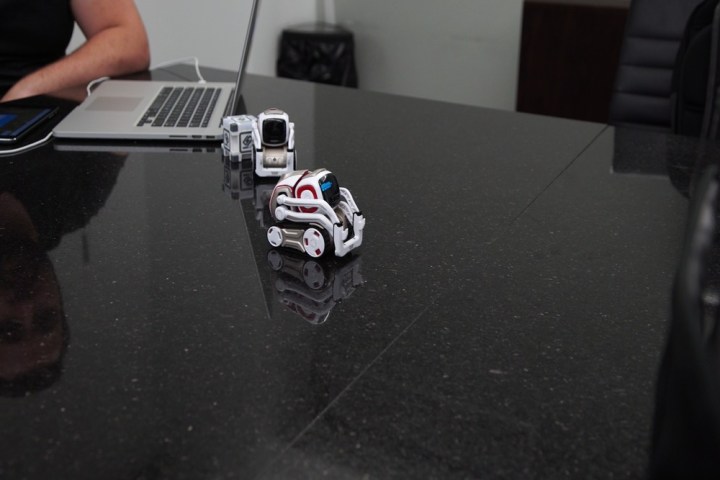
Anki’s motivations for doing so, explained Anki’s president and co-founder Hanns Tappeiner at a showcase in New York City, are twofold. First, the company wants to distill Cozmo’s deluge of mechanical parts, which include a gyroscope, accelerometer, cameras, a drop sensor, and four motorized joints, down to easy-to-understand functions that novice programmers can understand.
“[Cozmo] is very different from anything out there in terms of the number of tools at the software’s disposal,” Tappeiner said. Second, the company is angling to expose the toys’ more advanced features, like the ability to recognize and remember a familiar face, in a friendly, polished format that’s conducive to development.

The ultimate aim, said Tappeneir, is to put incredibly powerful resources — resources with up to four years of development and “thousands of lines of code” behind them — at the fingertips of both experts and dilettantes alike. He compared it to the advent of smartphone apps. “Pre-2007, if you wanted to be a mobile developer, you had to be a hardcore professional,” he said. “Only after the iPhone and Android has it become easy enough that almost anyone can make an app.”
The inherent complexity of robotics adds a wrinkle, though. While developing a moderately complex smartphone app might only require basic knowledge, programming a ‘bot is typically far more involved. As simple as a routine like obstacle avoidance might sound, said Tappeiner, the code is anything but. “You might be able to make a light blink or get the robot to drive straight, but to do anything else, you basically need a Ph.D in robotics,” he said. “There are people who literally spend their entire life figuring out that kind of stuff. The average person can’t or doesn’t have the time to worry about that [stuff].”
Anki’s solution is in the form of functions, or single-code, easy-to-use resources that encapsulate the company’s years of research. Cozmo’s software development kit, which developers access by plugging a smartphone or tablet running Anki’s companion app into their computer, includes hundreds of individual functions that let developers leverage everything from the Cozmo’s facial recognition to object avoidance.
Tappeneir showed one example, NumFaces, that “fires up nine thousand lines of code” to figure out faces are within Cozmo’s field of view. Another, LookAround, triggers the robot’s curious side — it’ll drive around and identify “things of interest,” or any objects it doesn’t recognize. And yet another, RollBlock, has Cozmo knocking over toy blocks on command. “You, as a developer, might just think, ‘I want to stack those two cubes,'” Tappeneir said. “Now, you don’t have to worry about it.

The breadth of tools at launch is extensive. In tow is facial tracking and facial recognition, the latter of which is accurate enough enough to detect a subjects’ gender and age, said Tappeiner. There’s even a function for pet tracking — Cozmo can distinguish between dogs and cats — and has options for playing back Cozmo’s various animations, sounds, and music.
And that’s just the tip of the iceberg. Intrepid programmers can supplement the list of available functions with their own code, said Tappeiner, which opens the door to integrations with “any internet-connected device” with a compatible web API. Cozmo will be able to pair with a Philips Hue bulb to dim the lights when you’re sitting in front of your living room TV, for example, or start a wireless coffee maker when you get out of bed in the morning.
The SDK will be released in stages, Tappeiner said. Phase 1 will be geared toward tinkering types who don’t mind getting their hands dirty — “hackers, students, and researchers.” A more stable release to follow will include support for visual programming languages like Scratch.
“The functions can be a high level, so it’s easy to wrap a graphical block around them,” Tappeiner said. “Kids will have access to actions like, ‘tell me whether the robot sees my mom right now.'” Already, he said, Anki’s partnering with “leading academic institutions, research labs and companies, and leaders in … education” to incorporate Cozmo into classroom curriculums.
Perhaps the most significant addition to the Cozmo platform, support for third-party app publishing, won’t land until the SDK’s final, third phase. Anki hasn’t settled on a distribution or pricing model yet, but the company eventually wants to facilitate the installation of custom apps beyond code repositories like Github. The team’s biggest hurdle, said Tappeiner, are the restrictions imposed on developers by some mobile app stores. “There are rules regarding what you’re allowed to do in an app store and what you’re not allowed to do,” he said. “But we’re working on it.”
Cozmo is available for pre-order now at the discounted price of $160. It’ll retail for $180 in October, and begin shipping with the SDK in the coming months.


